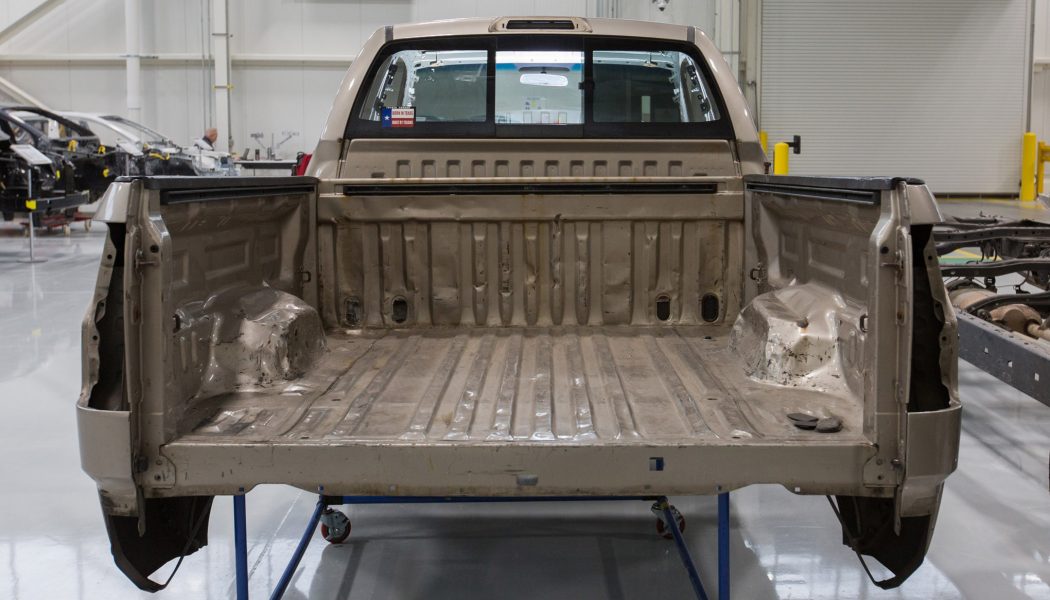Four and a half years ago, the odometer in owner Victor Sheppard’s 2007 Toyota Tundra pickup passed one million miles, with the truck still on its original engine, transmission, and paint—an impressive feat for a vehicle just nine years old. Toyota thought so, too, swapping the heavily used rig for a brand-new model and sending the Million-Mile Tundra on a months-long tour of various company facilities. Once that was complete, the Million-Mile Tundra’s body, interior, and mechanicals were torn down to examine how well its constituent parts held up during its high-mileage duty cycle. The plan was to identify any defects and work with engineering to increase future quality. Here’s what Toyota found:
It was the night shift on March 28, 2007, at Toyota’s Huntsville, Alabama, engine plant when the Beast’s 4.7-liter V-8 began life as a nondescript piece of cast iron. Machined on site and then transported on a line around the facility, the engine was quality-checked several times before making its way onto a shipping crate bound for Toyota’s San Antonio, Texas, assembly plant. The engine was one of several thousand the facility would build that year.
When the plant opened in 2003, it only built the 4.7-liter 2UZ-FE engine and was the only facility outside of Japan to build a V-8. Being a new plant with a small group of employees helped create a family atmosphere, as the employees focused on quality in an attempt to make an impression on Japanese headquarters. “Our goal was to make the best quality we could.” Shane Perry, Toyota production group leader said. “I don’t think a million miles ever crossed our minds, at least not mine.”
When the Million-Mile Tundra’s engine ultimately made its way back home, the Huntsville team was very eager to examine it. However, exactly how they would do so created a considerable debate. Perry wanted to start the process by putting the engine on a dynamometer to see how its performance had degraded over time. However, Bruce Myatt, Toyota quality manager, was very concerned about damaging the engine. Also making the dynamometer issue tough was the fact that Huntsville doesn’t build the 2UZ-FE engine anymore. Its dynamometer is set up for only the engines the plant currently builds, and it would need to make or modify parts, and even scavenge one from a display, to connect the engine to the dyno. “Perry called me one night and said they’d hooked it up,” said Myatt. “I was hesitant. He said it idled really well.”
The next night, the team turned it over and pushed the engine to its 5,700-rpm redline. “It was exciting to see the power figures from the engine in our cell,” said Gary Baker, quality team leader. “The engine performed better than many new engines off our line. ” Perry says the better numbers are likely due to the engine being broken in. However, for a mill with a million miles on it, the strong dynamometer results were impressive. The team now knew they had a good engine on their hands.
Tearing down would confirm their suspicions. From the piston heads, valve stems, crankshaft journals, and the block itself, the engine was in impeccable condition. Examining the parts in person was quite amazing. There was very little carbon buildup on the valve stems, the cross hatching was still visible on the cylinder walls, and the crankshaft journals had no visible wear marks. The only real blemish found was one slight mark on a bearing.
“We remeasured the head, the block, and cams in our lab,” said Connie Roberts, Toyota quality manager. “Nothing was abnormal. It wasn’t within specifications, but after a million miles it isn’t going to be. The biggest surprise to me was the bearings. They are probably the cleanest I’ve ever seen come out of an engine. ” After examining the parts, measuring them against specs and testing the engine on the dyno, the team was pleasantly happy to discover that, as it sits, the engine would have scored a 99/100 on their quality tests—high enough to pass it as a good engine. “We have seen our durability test engines have a considerable amount more wear and tear than this engine,” Myatt said several times during our visit. Each time he said it, he smiled.
The Rest of the Truck
Sitting 615 miles north of Huntsville lays the rest of the Tundra, now a collection of parts for the first time since it was on the assembly line in April 2007. Like the Alabama team, Toyota engineers didn’t initially start tearing it down. Rather, they all were eager to drive it, including one of the original ride and handling engineers from when the truck was first being developed.
“It held up extremely well,” said Stephen Provost, senior principal engineer in vehicle performance development. “The performance at the end was amazingly close to the original truck. We do an initial mileage accumulation with the trucks and then we drive them after that to get a sense of how they will perform through what would be considered a normal life cycle. It was amazing to see how close this Tundra was to a normal-accumulation-mile vehicle.”
Impressed with the driving dynamics of the truck even after all the miles, the team started a meticulous disassembly process, including removing the body from the frame. Each part was labeled and placed with similar parts on a collection of shelves. As with their Alabama colleagues, what they didn’t find is the amazing part of the story.
The most obvious visual cue that Sheppard really used the truck is the bed. With it removed and elevated on a rolling stand, the engineering team was able to thoroughly examine the bed from all angles. Viewing the dents from the top and underneath, the team didn’t find a single instance of a deformity due to engineering shortfalls. In fact, the only major damage is found on the wheel wells, which Sheppard told the team was due to pallets, a common item he loaded into the bed, being wider than advertised.
Remarkably, the tailgate itself still worked, even after Sheppard’s numerous cross-country hauls, which ranged from 1,500 to 2,700 pounds, were loaded and unloaded. The only casualty was the dampener, which, to no one’s surprise, didn’t work as well as a brand-new unit. “We can learn from the truck and how it was used,” said Kevin Gileo, executive program manager for the Tundra, “then feed that data back into the future development of the truck.”
Additional areas of interest are the frame and leaf springs. Sheppard carried a considerable amount of weight long distances through a variety of weather and road conditions. With Toyota’s history of frame rust issues, as well as the amount of weight often loaded into the bed, the expectation was there would be something to see. Like much of the truck, however, the unremarkable becomes remarkable. The frame didn’t show any surface rust and the leaf springs were in good shape.
“It is surprising with the loading this went through, how well the leaf springs held up,” said Gileo. “To be honest, we don’t really have a million-mile expectation, but it met the expectation [we did have].” It really is remarkable how well multiple items still work. For example, the driver’s side door latch, an item Sheppard used thousands of times, still worked exactly to specifications. The center-console latch and the glovebox tell the same story. Then there is the driver’s seat. This was a key item for Toyota engineers considering Sheppard said he often slept in the truck, and he’s not exactly a small guy. In fact, the seat was such a source of excitement and curiosity among the engineers it was shipped to Japan to be examined by a team there.
Having been returned to the U.S. technical center prior to our visit, it sat alongside the cloth interior that once covered it. After being thoroughly reviewed by American and Japanese engineers, the seat was found to be completely functional and meeting specification. “Seat architecture isn’t just a Tundra product, this is used in a variety of Toyota and Lexus products globally and various engineers wanted to see it. It’s impressive how well it held up.” Seat development involves a lot of testing, but can’t replicate this amount of use. Toyota engineers did find one tear on the cloth about the length of a quarter. This tear could have been from a variety of things and was a concern until they noticed the tear was just on the surface layer. It never made it through to the seat padding.
The reality is this truck—designed in Michigan, built in Texas, unique to Toyota’s global portfolio, and with a million miles on it—could still be on the road today with such a short list of needed repairs that a mechanic wouldn’t believe you. When the interior was stripped down to bare metal, as another example, it proved rust-free and looked very much like it did when the cabin trimmings were installed for the first time.
What’s Next?
With the truck thoroughly disassembled, both the Toyota Technical Center and Huntsville, Alabama, plant had similar plans: to bring in suppliers to look over their specific parts and continue to show off the components to various Toyota engineers. Then each group rebuilt the truck in a specific way for display. Huntsville intended to use it as a training tool for new employees when they talk about quality. Later, the Toyota Technical Center planned to set up a permanent display. In each case, the Million-Mile Tundra stands as a physical embodiment of Toyota’s mantra of quality, durability, and reliability. Well, until Sheppard brings in another million-mile Tundra to replace it.










